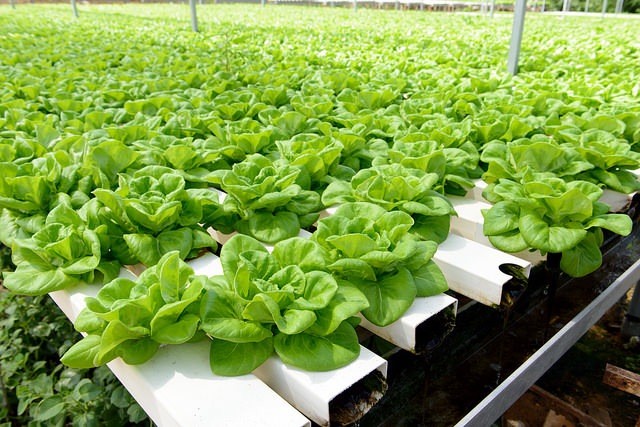Nutrient Film Technique, continued
This is page 9 of our twelve page series on nutrient film technique. Click any of the below pages to jump to that page.
Page 1 Page 2 Page 3 Page 4 Page 5 Page 6 Page 7 Page 8 Page 9 Page 10 Page 11 Page 12

A large scale commercial NFT operation. A DIY approach here would need to be based on solid production data to provide optimal performance. Many commercial operations of this size opt for turnkey systems so that they don't spend valuable employee time assembling systems. Alternately, some companies opt to standardize their NFT systems and build them in-house using well-documented procedures. A careful cost/benefits evaluation would help determine which approach would be most cost-effective.
Do It Yourself Potential for Nutrient Film Techniques, Continued
The second caveat is the issue of channel length. A pre-engineered nutrient film technique system will have worked out how long the channel should be, relative to the intended plants, reservoir size, nutrient solution plumbing, and slope. Each of those variables will determine how much nutrient solution will be absorbed along the way, creating a functional limit to how long the channel can be. In other words, different plant densities, plant types, spacing, slope, and plumbing details will determine a maximum length for that channel. Anything beyond that and the plants won’t get enough nutrients. DIY’ers can determine this experimentally by setting up the system they want, and then seeing if the plants at the end are stunted in some way. However, that requires a fair amount of growing time, and lost productivity if the plants at the end don’t reach their full potential. For hobbyists, that might be an OK tradeoff. For folks who need their systems to perform well, that’s an expensive set of tests.
The third caveat with nutrient film technique is the issue of slope. Similar to what we just discussed, there is a functional ‘sweet spot’ in terms of channel slope which can be difficult to nail down. Too much slope and the nutrient solution washes over the roots too quickly, such that the plants are starved of nutrients (or dry out entirely). Too shallow a slope and the plants run the risk of becoming waterlogged. While this too can be determined experimentally, it will take a fair amount of fiddling around with the system to get it right. For hobbyists and tinkerers, that might be part of the DIY reward. For the commercial producer, that can cost time, money and energy that could have gone into growing more crops more efficiently.
These issues lead to one unfortunate aspect of nutrient film technique: a system designed for one particular crop cannot easily be switched over to another crop without changing quite a bit of the system in the process. Even after a grower figures out slope, length, spacing and all the rest for a single crop, say lettuce, all those numbers go right out the window with another crop, say tomatoes or strawberries. The most successful NFT systems are those which have already been “dialed in” for their intended crops, and which grow those crops over and over again. In that context, one strategy for dedicated DIY’ers is to search out other growers who already work with the desired crops, and then take careful notes about how their system is set up. For instance, if a grower wants to specialize in lettuce, spending some time looking at other lettuce growers (or researching lettuce NFT systems online) will provide at least some of the variables listed above. That can cut down on the experimental phase significantly.
So perhaps the question which any given grower should ask him/herself is this: what is the priority? If experimenting with NFT systems is the priority, then yes this approach is imminently suited to DIY methods. For those growers who need to build a system once and have it provide optimal production right away, then the DIY approach may yield more headaches than profits. One very closely related question is whether growers want to raise one crop over and over again, or a wide variety. Growers who want to specialize in just a few crops can therefore plan and build a system once and it’ll perform nicely for many years to come, with just standard maintenance and the occasional repair. For growers who know they want to work with multiple crops will either need to do a lot of experimentation, do a lot of homework in advance, or tolerate a lot of sub-optimal production as they test out various layouts. Asking these questions in advance can help determine which approach will be the most satisfying.Back Next
Click any of the below links to jump to that page.
Page 1 Page 2 Page 3 Page 4 Page 5 Page 6 Page 7 Page 8 Page 9 Page 10 Page 11 Page 12